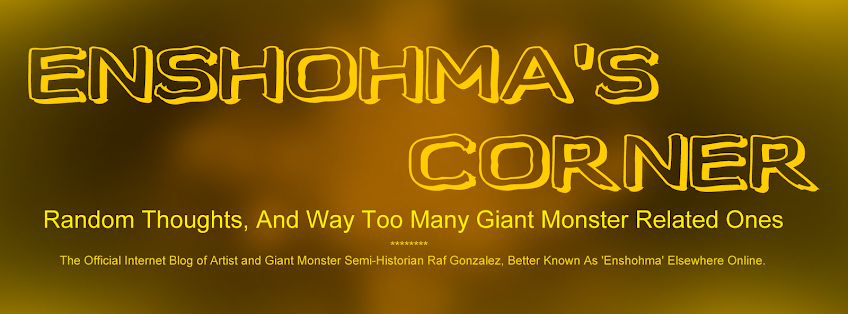Nothing major for today but I wanted to share the promotional artwork (possibly concept art) done for the television version of VOYAGE TO THE BOTTOM OF THE SEA (1964-1968), featuring four giant sea monsters that never made it into the series proper.
Like my previous post on Tabby-Imago, I'm using self-created nicknames for the following creatures to simplify the descriptions and because I just want to (if every other Godzilla and Power Ranger fan gets to name the unnamed, why not me?).
The first creature, which I'm nicknaming The Clawed Chimera, appears to be a combination of several sea animals, but the prominent claws give the initial impression that it's a simple giant crab before noticing the rest of the aforementioned bodily features. To my knowledge, there are at least two crustacean-based monsters in Voyage to the Bottom of the Sea: a giant aquatic spider-like creature in "The Monster's Web" (February 27, 1966), and the titular human-sized antagonist of "The Lobster Man" (January 21, 1968).
Confusingly, the main villain behind "The Deadly Dolls" (October 1, 1967) is mockingly dubbed 'The Hermit Crab' by the show's heroes, even though the being itself is a highly advanced, energy-like machine intelligence from the distant future seeking to possess The Seaview (the show's iconic submarine) for its new physical form.
As for the second monster featured: I've always had a preference for plesiosaur-like kaiju and characters, so you know which one I like between these two otherwise nifty critters. However, the lack of two-out-of-four pictorial fins gives me hesitation about nicknaming him The Abyssal Plesiosaur, with the vague alternative of Abyssal Sea Serpent matching the odd design better.
Beyond that, the art itself is very good, especially the luminous backlighting, but I will admit the serpent's eerily calm face might turn off most monster and horror fans.
My least favorite monster in these paintings, Pink-Tooth the Sea Beast (if you can think of something better, please share), is probably my least favorite of the four, but the mudskipper-like shape and long grasping arm-like front fins positively reminds me of the Ichthyosaurus Mercurius from The Outer Limits episode "Tourist Trap" (December 23, 1963).
Last but not least is The Black Devil Dragon, who is probably the coolest-looking monster of the promotional paintings and the one that I would loved to have seen in a completed episode, possibly as some ancient and terrifying menace that The Seaview accidently awakens from an undersea volcano. Or an aboveground volcano, seeing how that's The Flying Sub firing beams at the opposing giant.
I rediscovered these paintings in my personal archives and combined the small files into slightly larger and more presentable collages above. I tried to re-locate the old Voyage to the Bottom of the Sea site I collected (stole) these from but to no avail. If I rediscover said website or stumble upon the real official names of the featured monsters, I'll gladly update this article in the future.





